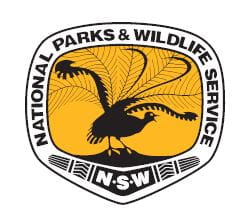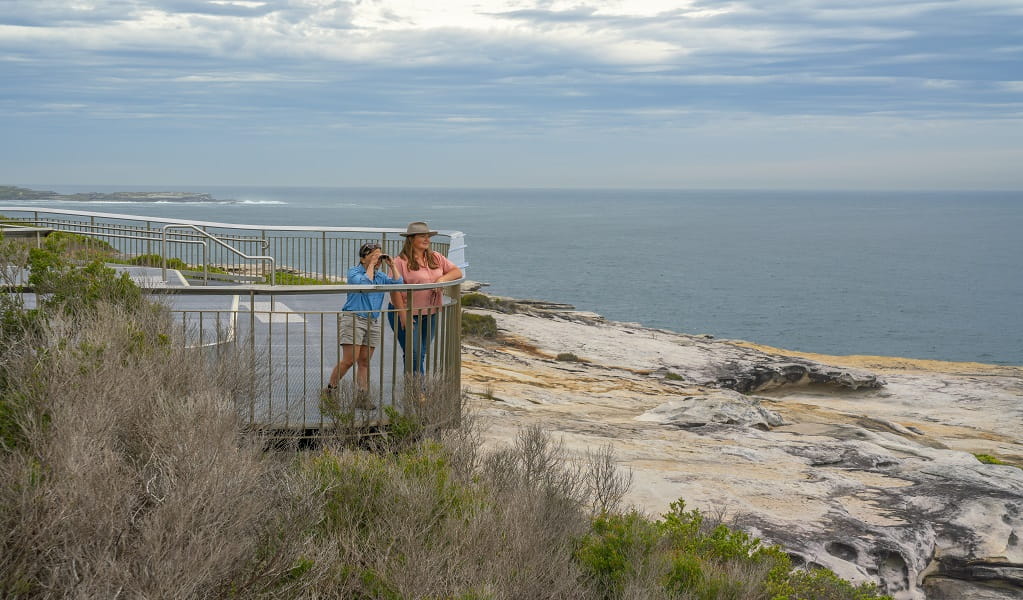Whales and wildflowers guided walk: Cape Solander
Kurnell area in Kamay Botany Bay National Park
Overview
Walk alongside a NPWS Discovery Guide on a 2-hour guided tour of the magnificent sandstone cliffs at Cape Solander. Keep a look out for both whales and wildflowers as you learn about the Kurnell area in Kamay Botany Bay National Park.
- When
Tour time: 9am to 11am. Meet at 8.45am.
Tour dates:
- 29 June 2025
- 5,8,12, 15, 19 July 2025
- 27,30 September 2025
- 4, 7, 11, 18, 25 October 2025
- 1 November 2025
- Where
- Cape Solander, Kurnell area
- Accessibility
- No wheelchair access
- Grade
- Medium. Suitable for adults and children aged 5 years and above. Children must be under strict supervision by an adult due to proximity of walking trail to cliffs.
- Price
-
Adult $20. Concession/Child (5 to 16 years) $15. Family (2 adults, 2 children) $50.
- Entry fees
-
Park entry fees apply
- Meeting point
- Whale watching platform, Cape Solander.
- What to
bring - Sunscreen, drinking water, snacks, sturdy shoes, suitable clothing
- Bookings
- Bookings required. Phone 1300 072 757 for more information or book online.
- Availability
- Group bookings available on request. For more information, please email or call NPWS Discovery team – Sydney South office on 02 9542 0615.
Join a 2-hour guided walk with a Discovery ranger along the spectacular coastline of Kamay Botany Bay National Park. Enjoy exquisite views as you watch for whales and explore the wildflower covered coastal heath of Cape Solander.
You'll walk 4km through stunning scenery from Cape Solander lookout to Tabbagai Point and back. Learn about the diverse wildflowers that create an ever-changing display along the trail. Bring your camera to capture picturesque pockets of colourful native blooms.
Cape Solander is one of Sydney's best whale watching spots. Look for humpback whales, common bottlenose dolphins and Australian fur seals as they pass the cliffs. You may even spot a rare sighting of a southern right whale. You'll hear about the fascinating journey of marine mammals as they migrate up and down the coast.
Bird watchers can look to the sky for white-bellied sea eagles, nankeen ketsrels and black-shouldered kites. You might even be lucky enough to spot yellow-tailed black cockatoos or the elusive king quail.
Bring your binoculars for a closer look, a snack to eat and clothing for all weather. There are no amenities at Cape Solander or along the tour.
Local alerts
For the latest updates on fires, closures and other alerts in this area, see https://www.nationalparks.nsw.gov.au/things-to-do/guided-tours/whales-and-wildflowers-cape-solander/local-alerts
Operated by

- NSW National Parks & Wildlife Service
Park info
- in the Kurnell area of Kamay Botany Bay National Park in the Sydney and surrounds region
7am–7.30pm August to May. 7am–5.30pm June to July.
Areas may have to close at times due to poor weather or fire danger.
-
Park entry fees:
$8 per vehicle per day applies in the Kurnell area only. The park has coin-operated pay and display machines - please bring correct coins. The park also has credit card accepting payment facilities.
Buy annual pass.
Visitor info
All the practical information you need to know about Whales and wildflowers guided walk: Cape Solander.
Getting there and parking
Cape Solander is in the Kurnell precinct of Kamay Botany Bay National Park. To get there:
- Follow Captain Cook Drive towards Kurnell
- At the T intersection turn left and take the next right to Cape Solander Drive
- Continue past the visitor centre and follow to the end.
By bus:
- Take service #987 from Cronulla to Kurnell
- Alight at stop F, Captain Cook Drive and Cape Solander Drive
- Join the Polo vehicle track at the end of Polo Street
- Follow the track to the Cape Solander vehicle track until you meet Cape Solander carpark
Park entry points
Paid parking is available at Cape Solander car park. Cost is $8 per vehicle per day. Payment options include pay machines, Park ‘n’ Pay App or Kamay Botany Bay National Park ticket booth (when in operation).
Parking can be limited during weekends and holidays.
Road quality
- Sealed roads
Vehicle access
- 2WD vehicles
Weather restrictions
- All weather
Parking
Parking is available at Cape Solander carpark for $8 per vehicle per day.
Payment options include pay machines, the Park ‘n’ Pay App or pay or you can pay at the Kamay Botany Bay National Park ticket booth (when in operation).
Please allow extra time for parking, as it may be limited.
By public transport
You can travel to the Kurnell area on public transport. Plan your trip using Transport NSW's Trip Planner.
Maps and downloads
Accessibility
Disability access level - no wheelchair access
Visitor centre
-
Kurnell Visitor Centre
21 Cape Solander Drive, Kurnell NSW 2231 - CLOSED TO VISITORS. Email and phone contact only. Monday to Friday, 10am to 3.30pm. Saturday, Sunday and public holidays, 9.30am to 4pm. Closed Christmas holiday.
- 02 9668 2010
Learn more
Whales and wildflowers guided walk: Cape Solander is in Kurnell area. Here are just some of the reasons why this park is special:
Whale watching

June/July is the best time to see humpback whales in this area as they migrate to warmer waters, and Cape Solander is a terrific lookout to get a glimpse of these majestic ocean giants.
- Cape Solander Head to one of Sydney's best whale watching spots. Cape Solander, located in the Kurnell section of Kamay Botany Bay National Park is an unbeatable lookout during whale watching season.
- Kurnell Visitor Centre Kurnell Visitor Centre is closed while a new visitor centre is being built. You can still contact our staff for maps, history and advice by email or phone.
- Muru and Yena tracks Mura and Yena tracks form a short 2.5km loop walk and pass by Yena picnic area, in the Kurnell area. Enjoy coastal views, birds and wildflowers.
Aboriginal culture to discover

At the time of the first encounters with Europeans, Aboriginal people of 2 different nations – the Goorawal People and the Gweagal People – were living in the area which now includes Kamay Botany Bay National Park. Significant Aboriginal sites have been recorded in the park, including middens and engravings.
- Burrawang walk Take this short, wheelchair-accessible stroll along Burrawang walk in the Kurnell area and enjoy several historic sites. You can't miss the 3 bronze sculptures that mark the 250th anniversary of the encounter between Aboriginal Australians and the HMB Endeavour crew.
- Kamay Botany Bay Aboriginal cultural tours Join the Burraga Foundation on an Aboriginal cultural tour through the spectacular landscapes of Kurnell area in Kamay Botany Bay National Park. You’ll learn about the ancestral stories, practices and traditions of the Dharawal People.
Sharing traditional knowledge

The Gamay Rangers have been appointed as ‘honorary rangers’ for Kamay Botany Bay National Park. Part of the Commonwealth Indigenous Ranger Program, which is designed to support Indigenous Australians to protect and conserve land and sea Country, the Gamay Rangers work alongside the NSW National Parks and Wildlife Service. The Gamay team share traditional knowledge and techniques, and are involved in the management of natural and cultural resources, protection of marine wildlife, and operation of the national parks on their cultural areas.
- Burrawang walk Take this short, wheelchair-accessible stroll along Burrawang walk in the Kurnell area and enjoy several historic sites. You can't miss the 3 bronze sculptures that mark the 250th anniversary of the encounter between Aboriginal Australians and the HMB Endeavour crew.
- Kamay Botany Bay Aboriginal cultural tours Join the Burraga Foundation on an Aboriginal cultural tour through the spectacular landscapes of Kurnell area in Kamay Botany Bay National Park. You’ll learn about the ancestral stories, practices and traditions of the Dharawal People.
Historic heritage

Kurnell is Captain Cook's Landing Place and the point of first contact between Aboriginal people and the Endeavour crew. The Kurnell area of Kamay Botany Bay National Park is rich in both Aboriginal and European history and is certainly a cornerstone of the country's colonial history. One of Australia's earliest European explorers, James Cook, landed here in 1770. Cook's botanists, Joseph Banks and Daniel Solander, first explored Australia's natural world here. After the reports of Cook and Banks, Botany Bay was recommended as a suitable site for settlement but upon inspection by Captain Arthur Phillip it was found unsuitable as it had no secure fresh water or suitable anchorage – so Sydney Cove was set up as the penal colony instead
- Captain Cooks landing place Visit Kurnell to see Captain Cooks landing place and the place of encounter between Aboriginal Australians and the crew of the HMB Endeavour in 1770. This heritage-listed site is an important place in Australia's history.
- Commemoration Flat picnic area Commemoration Flat picnic area is in the Kurnell area of Kamay Botany Bay National Park. This beautiful grassy spot is perfect for seaside family gatherings.
Plants and animals protected in this park
Animals
-

White-bellied sea eagle (Haliaeetus leucogaster)
White-bellied sea eagles can be easily identified by their white tail and dark grey wings. These raptors are often spotted cruising the coastal breezes throughout Australia, and make for some scenic bird watching. Powerful Australian birds of prey, they are known to mate for life, and return each year to the same nest to breed.
Plants
-

Blueberry ash (Elaeocarpus reticulatus)
The blueberry ash is a rainforest shrub which produces blue olive-shaped berries and spectacular bell-shaped flowers, which often appear on the plant together. It is a tall slender shrub or small tree found in rainforest, tall eucalypt forest and coastal bushland in eastern NSW, south-east Queensland and Victoria.
-

Flannel flower (Actinotus helianthi)
The delicate flannel flower is so named because of the soft woolly feel of the plant. Growing in the NSW south coast region, extending to Narrabri in the Central West and up to south-east Queensland, its white or pink flowers bloom all year long, with an extra burst of colour in the spring.
-

Old man banksia (Banksia serrata)
Hardy Australian native plants, old man banksias can be found along the coast, and in the dry sclerophyll forests and sandstone mountain ranges of NSW. With roughened bark and gnarled limbs, they produce a distinctive cylindrical yellow-green banksia flower which blossoms from summer to early autumn.
-

Smooth-barked apple (Angophora costata)
Smooth-barked apple gums, also known as Sydney red gum or rusty gum trees, are Australian native plants found along the NSW coast, and in the Sydney basin and parts of Queensland. Growing to heights of 15-30m, the russet-coloured angophoras shed their bark in spring to reveal spectacular new salmon-coloured bark.

